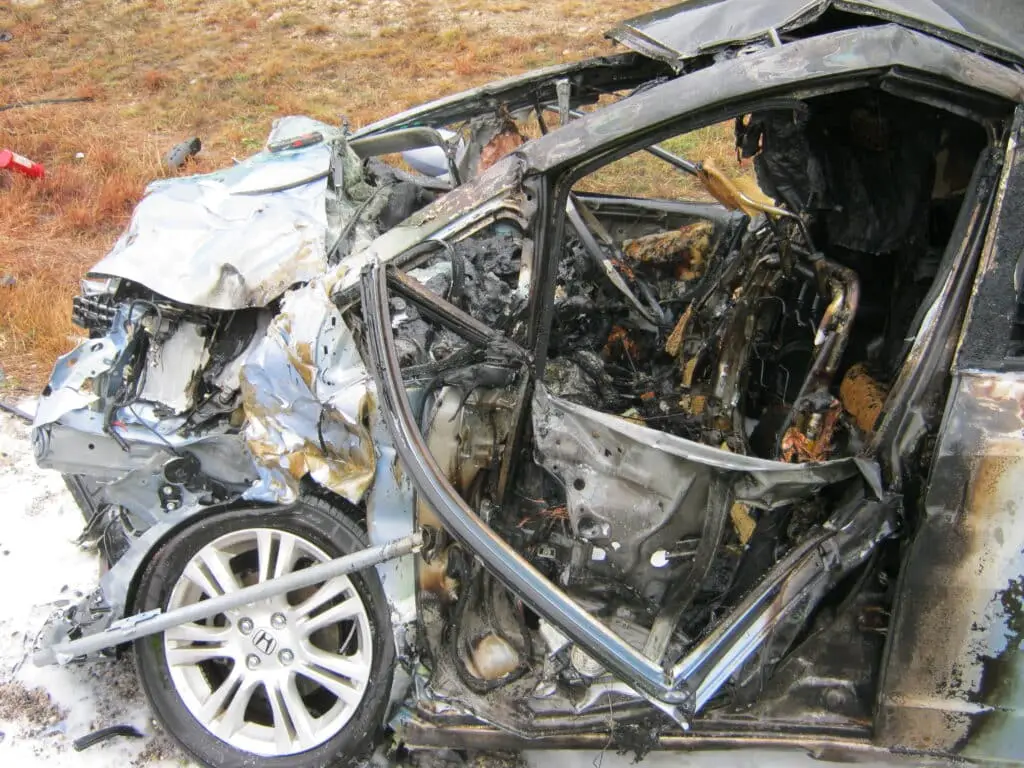
Table of Contents
ToggleDallas Couple Did Not Know About Defective Car Repair Until It Was Too Late

Fraudulent body work by John Eagle Collision Center pinned Matthew Seebachan inside the burning wreckage of his used 2010 Honda Fit as fire devoured his feet and legs according to a defective car repair lawsuit filed in Dallas, Texas.
The 33-year old Dallas pharmacy technician struggled to free himself from a fire fed by the punctured gas tank beneath his seat. As flames engulfed his lower legs, a Marine and his father ignored bystanders warnings that the car was about to blow up. They pried open the passenger door to rescue Seebachan’s 29-year old wife Marcia who was unconscious suffering from a ruptured main artery Both of the men then pulled Matthew out the driver’s side window, but first Seebachan had to reach into the flames to free his foot which was stuck under a pedal.
When Dr. Karen Kowalske, a burn rehabilitation specialist at UTSouthwestern Medical Center in Dallas was asked to rate Matthew’s pain on a one to ten scale, she replied 1,000.
John Eagle Collision Center’s Dirty Little Secret About Defective Car Repairs
The young couple purchased the used Honda Fit four months before the accident. Little did they know that John Eagle Collision Center in Dallas had glued on its steel roof to replace hail damage. That’s right glue!
The couple’s defective car repair lawsuit against John Eagle Collision Center and its billion dollar chain of Texas dealerships exposes a dirty little secret in the body shop world. The so called Honda “certified” body shop had replaced the Honda’s hail damaged roof for its previous owner by gluing a new steel roof on to the car’s structure. John Eagle did not follow Honda’s Repair Specifications which called for the new steel roof to be welded on to the Honda Fit’s steel safety cage at 104 spots. Yet, John Eagle Collision Center pocketed $8500 from the insurance company for gluing and not welding on a new steel roof panel as specified by Honda.
In pretrial testimony Boyce Willis, the Body Shop Director for John Eagle Collision Center, admitted that the so called “Certified” body shop deliberately ignored and violated Honda’s Manufacturer Repair Specifications justifying the practice by stating, “We’re guided by insurance…if you brought your car into my shop, the insurance company’s going to dictate what — how we’re going to repair your car.”
John Eagle Allegedly Cover Ups Dangerous Defective Repair With Fresh Coat Of Paint
Vehicle safety lawyer Todd Tracy of the Tracy Law Firm in Dallas says the revelations in the lawsuit should alarm the 5,000 people who get their vehicle’s repaired by John Eagle Collision Center’s auto body shop in Dallas every year. John Eagle also operates a major collision center in Houston.
“Instead of following what the manufacturers tell them to do, John Eagle Collision Center does what they need to do to get paid. In my book that’s arrogance, and in my book that’s dangerous, and in my book that’s deadly because people have no idea what these certified body shop repair facilities are doing because they cover it up with shiny new paint. They cover it up with sparkling chrome trim. And they cover up dangers and time bombs that will explode if the owner is in a car accident.”
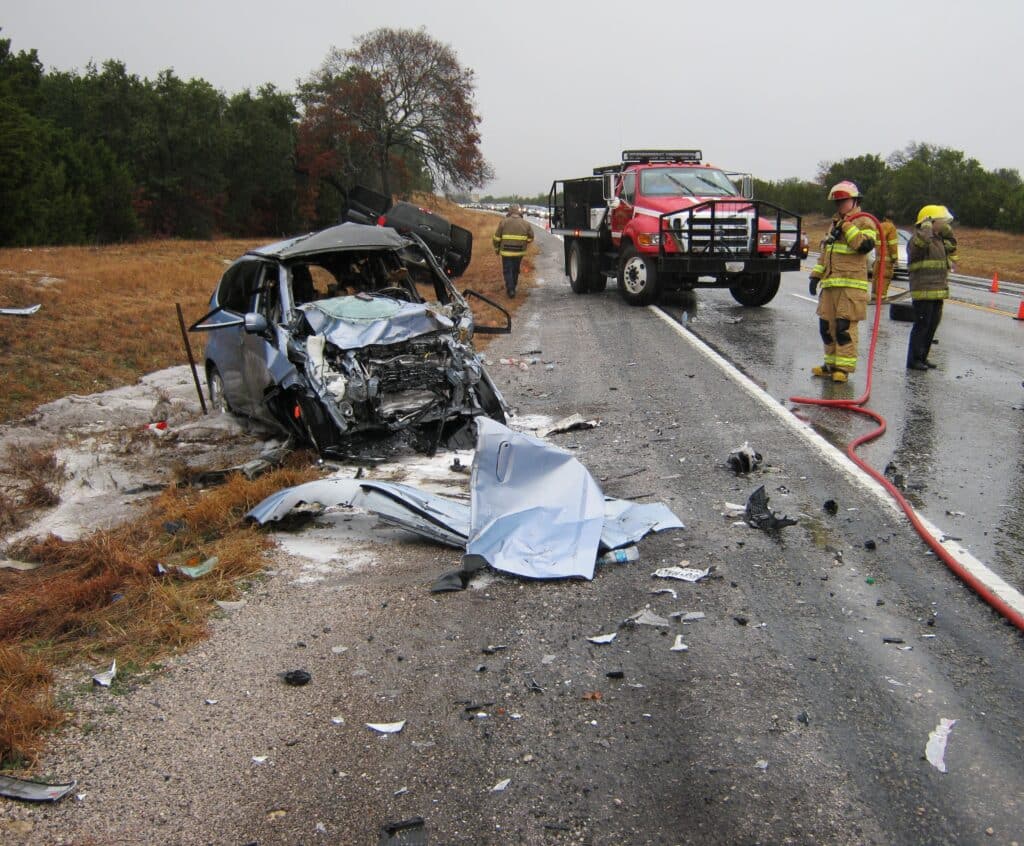
The Seebachan’s were driving to her Grandmother’s home in the Texas Hill Country during the Christmas holidays of 2013 when a Toyota Tundra pickup hydroplaned and hit sideways into the front end of the their Honda Fit.
When they bought the used Honda, no one told them that John Eagle Collision Center in Dallas had used glue to replace a hail damaged roof on the car for its previous owner. And they certainly could not tell what was hidden beneath the shiny paint job and trim.

John Eagle Collision Center Admits It Ignored Honda’s Repair Specifications
The body shop director at John Eagle Collision Center, Boyce Willis, admitted in pretrial testimony that the company ignored and violated Honda’s repair specifications when it glued a new roof on to the 2010 Honda Fix. Honda’s official repair manual for dealers specified that a new roof should be welded on to the car.
Reading from Honda’s Body Repair Manual for the 2010 Honda Fit, Willis repeated its bold letter Warning, “You can be killed or seriously hurt if you don’t follow instructions.” Willis also testified that the John Eagle Collision Center used an adhesive made by 3M despite the fact that 3M specifically stated that Honda does not permit the use of adhesives.
The lawsuit alleges John Eagle Collision Center deliberately disregarded Honda’s standards even though its website claims it performs customer’s body work in accordance with Original Equipment Manufacturer (OEM) specifications. And that such conduct shows a total lack of regard for human life.
In the wake of news reports by WFAA Channel 8 and CBS 11 News in Dallas about the defective body shop repair lawsuit, even the collision repair industry’s own Society For Collision Repair Specialist is now calling attention to the risks of not following the manufacturer’s standards.
John Eagle’s Defective Repair Caused A Domino Effect That Crushed The Seebachan’s According To The Lawsuit
Automotive and biomechanical engineers examined the wrecked 2010 Honda Fit at the Tracy Law Firm’s Crash Lab in Dallas. They concluded that the Seebachans would likely have had only minor injuries if the roof been properly welded on by John Eagle Collision Center as specified by Honda’s body repair manual.
None of the three occupants including an infant riding inside the Toyota pickup truck that struck the Seebachan’s Honda suffered injury.
The failure of the glued roof set off a domino effect of structural failures that caused the Honda Fit’s safety cage to collapse which in effect crushed the couple like they were inside a trash compactor and punctured the gas tank located under the driver’s seat.
Todd Tracy, “In any vehicle, a safety cage surrounds our families. This safety cage protects the driver and passenger from serious injury in a head on collision, in a T-bone broadside collision, in a rear end collision, and in a rollover accident. What keeps that safety cage together is the roof and the floor. It’s no different than building a house. You want a strong foundation and a strong roof. If the foundation and roof are not solid, your house will blow away in a storm.
The same is true for your vehicle. If you don’t have a strong roof and you don’t have a strong floor, it doesn’t matter if the side, front, and rear structure is good. Your vehicle’s safety cage is going to fail. That’s why car manufacturers weld their roofs to the safety cage. That’s why they tell their dealers to weld new roofs to the safety cage. Car manufacturers don’t use glue. You know who uses glue? Children in kindergarten use glue. And tragically, John Eagle Collision Center uses glue to paste roofs back on.”
You can watch Tracy demonstrate how a glued on roof fails in this video.
John Eagle’s Glued Honda Roof Failed Without 104 Spot Welds
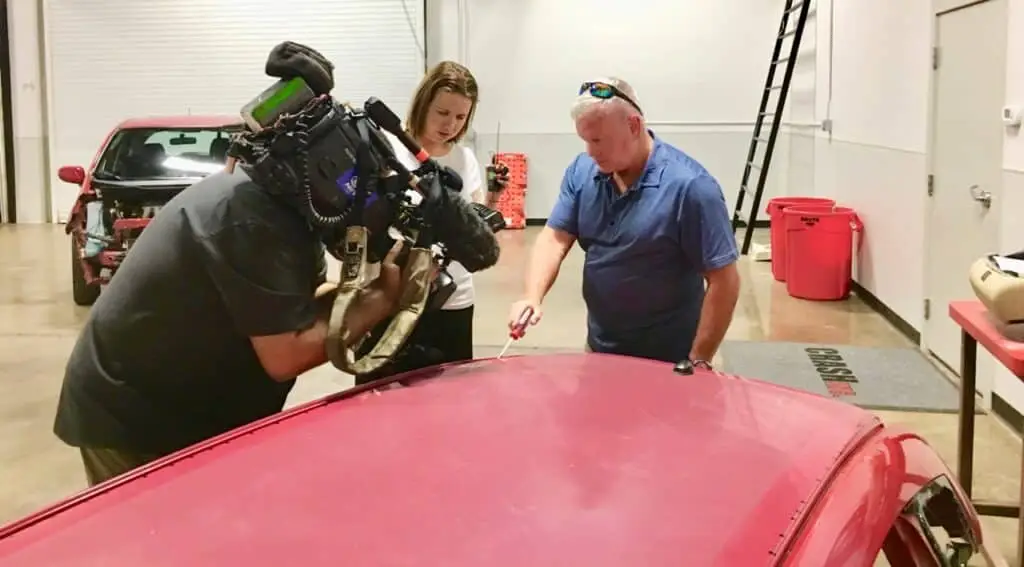

Defective Glued Auto Body Work Hidden On Used Honda
Four months before the car wreck, the Seebachan’s bought the used Honda Fit from Huffines Kia in Denton. The CARFAX report given to the Seebachans at the time of their purchase did not disclose the body work. It’s impossible for the owner of car or the buyer of a used car to know if a “Certified” body shop follows the Manufacturer’s Repair Specifications because as Todd Tracy demonstrates in this video you can’t see what’s under a fresh coat of paint and new trim.
Marcia Seebachan says she was shocked to learn after the accident that they had bought a Honda with a glued roof that did not meet Honda Repair Specifications. In this video, she says they would never have bought the car if they had been told the roof had been replaced.
https://claritydigital.wistia.com/medias/wwju9qmpq3?embedType=async&videoFoam=true&videoWidth=640
The Insurance Institute for Highway Safety named the Honda Fit a “Top Safety Pick” after conducting crash tests. Those tests nearly duplicate the Seebachan’s wreck and show that they should not have suffered severe injuries.
“When the John Eagle Collision Center claims to be a manufacturer “certified” body shop repair and doesn’t follow the Original Equipment Manufacturer’s (OEM) guidance, their expert guidance, people get crushed and maimed for life because the safety cage fails. That’s exactly what happened to Matthew and Marsha Seebachan on December 21, 2013 when they realized that their roof had been glued on rather than welded,” says Tracy.
The Reference for this defective body repair lawsuit is as follows:
Cause No. DC-15-09782
192nd Judicial District Court
Dallas County, Texas
Accident Scene Photos From the Fraudulent Repair Lawsuit Against John Eagle Collision Center
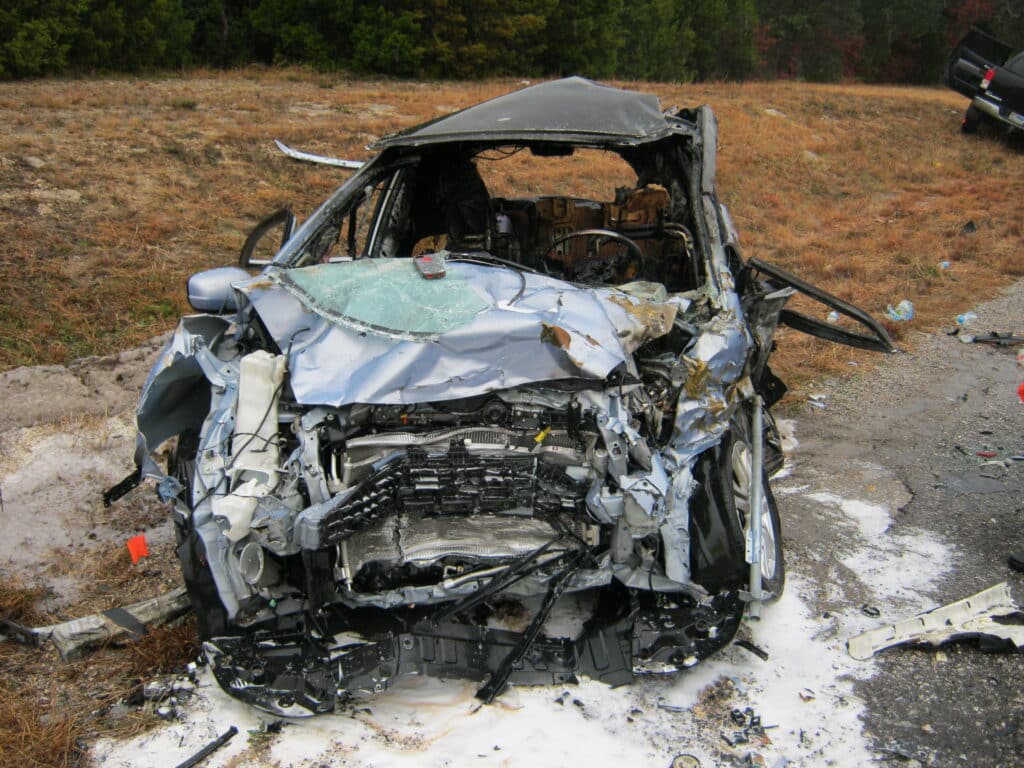
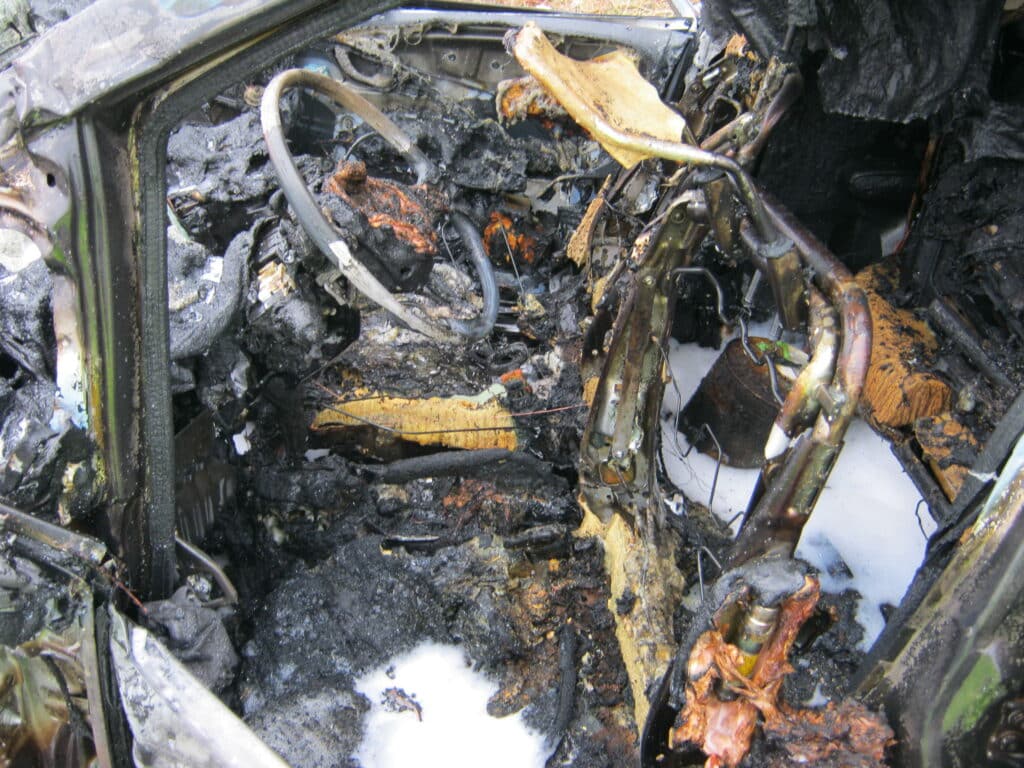
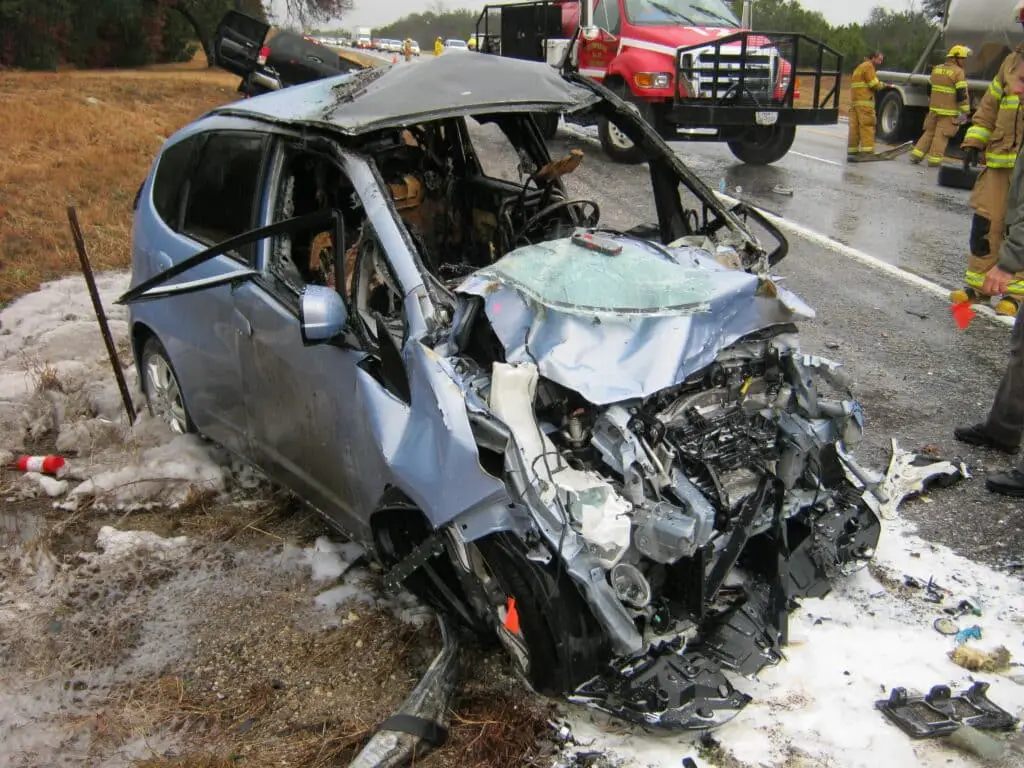
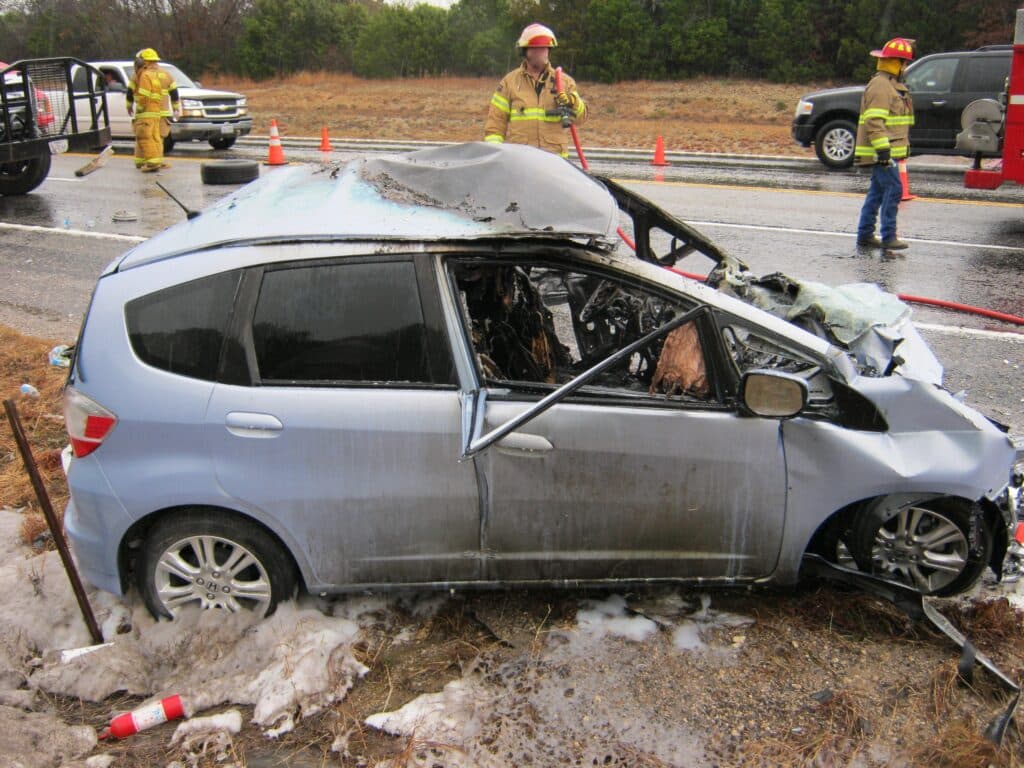
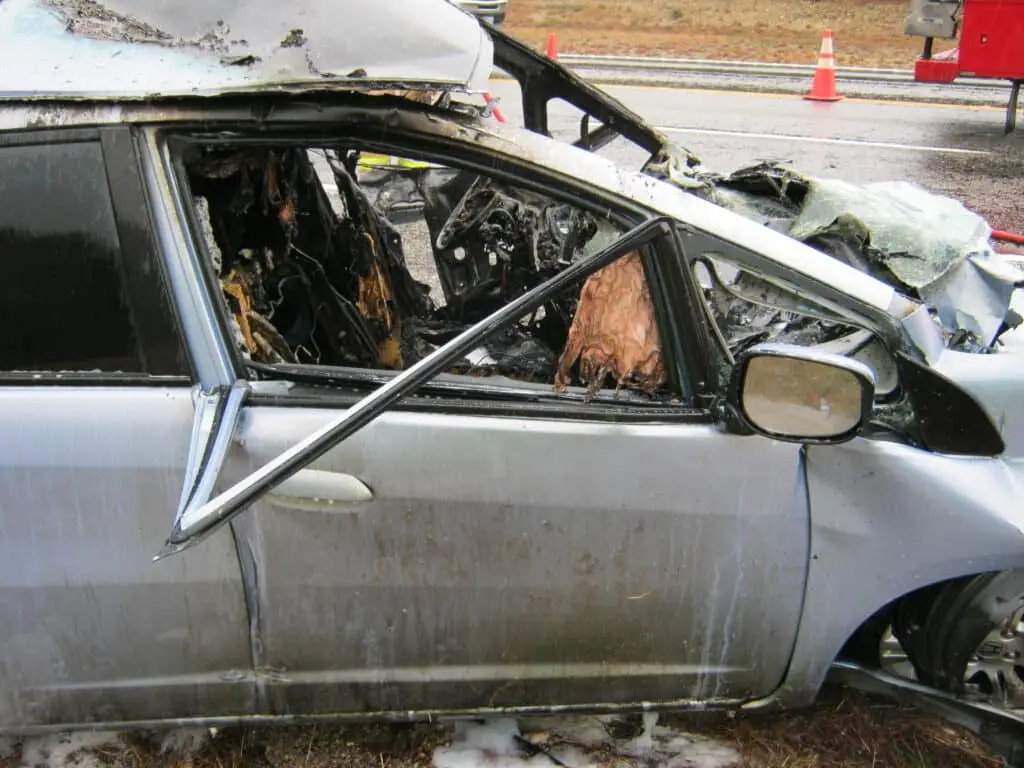


11 Responses
Had the roof replaced on my wifes 2007 Toyota Camry a few years back. How can you tell if its welded or glued?
John, unfortunately there is no way to tell unless you are in an accident. You can check the bill to see if the body shop stated that they would restore your Toyota to Original Equipment Manufacturer standards. Did John Eagle Collision Center do the work? Feel free to call our office if we can be of help 214-324-9000.
Go to a reputable shop and have them look under the headliner. They will be able to tell by looking at the underside of the roof. At the front of the roof under the windsheild there will be visable indicators on how it was repaired. Same on the underside of the roof directly below the back glass. Welds leave distinct marks on the backside of metal vs glue would look untouched. Welding burns the paint. Glue does not.
The amount of collision damaged cars improperly repaired and back out on our roads we all must share and car lots for sale is staggering, to many consumer advocacy groups that have this data but cannot quantify its accuracy. Just imagine altering an SRS (Air Bag) system 700/1000 second difference thus making a life and death change to the engineering of that system, how easy is that? Just put a non-OEM part in place of an OEM part and it will (yes I said will) occur, the problem is the game of Russian Roulette and when will it be needed and who will take the time afterwards to investigate. Collision damaged cars being totaled out at an all time high isn’t the answer these cars are rebuilt and resold at an even less standard.
Force the collision repair industry at large to become technician licensed NOT shop licensed and force those techs to train to a OEM standard level. Shops must employ such trained staff and have the equipment to do the work. Salvaged cars must never be allowed on the road again EVER! Destroy titles once totaled.
One problem with that. Most body techs are certified, but as long as insurance companys have control over the body shops it dosent matter who is certified. Insurance adjusters have no repair experience but they are the ones who write the repair bids and write the check to pay for it. They control the process by simply refusing to pay to have it repaired any way other than they have been taught by the insurance company in the month long training for their job. Shops would love to do everything by the book but who will pay for it? Definitly not the insurance companies.
More Certifications wont help. Look at the Hair stylist or the plumber. Have you never had a bad hair cut or had a plumber have to come back out to your home for a re-do. the problem is the insurance companies that are running the repairs and shorting the shops to pay it correctly. look at shops labor rates and realize these techs make between 60-110k Annually. At what the insurance says is a fair rate of $48 per hour (note the amount of equipment and the expense of such equipment) shops should charge between $75-115 per hour. big issues, and the state regulators don’t give a crap about the shops.
Insurance companies force shops and techs to take shortcuts in order to survive in this trade !! it is what it is , a shop and or technician can not make a living doing everything by the book and not being paid properly for it … cycle time and pushing cars out fast through the shop is all that’s worried about until something bites a shop like this and THEN everyone points to the technican and blames them which is unfair because it’s the industry that’s forcing them to get the cars out as fast as they can to get more cars in . Either they do it or get pushed out themselves and another tech replaces them.
Wasn’t Allstate their insurance company and refered them to that body shop to save Allstate repair costs /
They were insured by State Farm.
Wow I. Shocked
Myself, working in the Autobody industry for many years and holding several certifications, one thing this article does not bring to light is the insurance industries greed and bullying of an otherwise honorable and honest profession. Insurance carriers should not dictate repair costs and methodology. If the law says a customer can use any shop, then the cost should be the cost. However State Farm in this particular case either bullied or coerced John Eagle to perform this repair sub par in the chase of profit. That is the true culprit in this case that made otherwise good people who wanted to do a good job make a very terrible decision in order to make a living. The original welding in a rook repair would have exceeded 10,000 dollars. I don’t know the financial liability State Farm Insurance had to bare, if any at all, but they are just as culpable for creating this environment of profit over safety and a job well done.